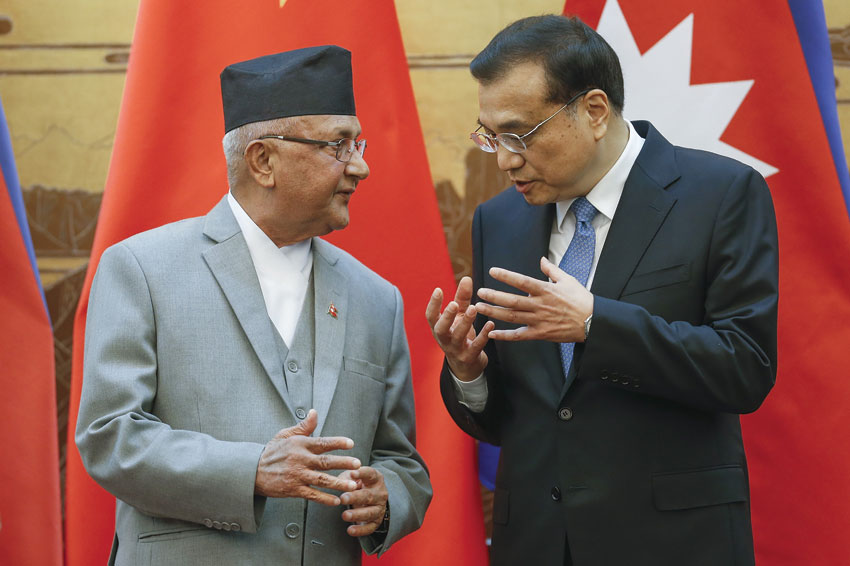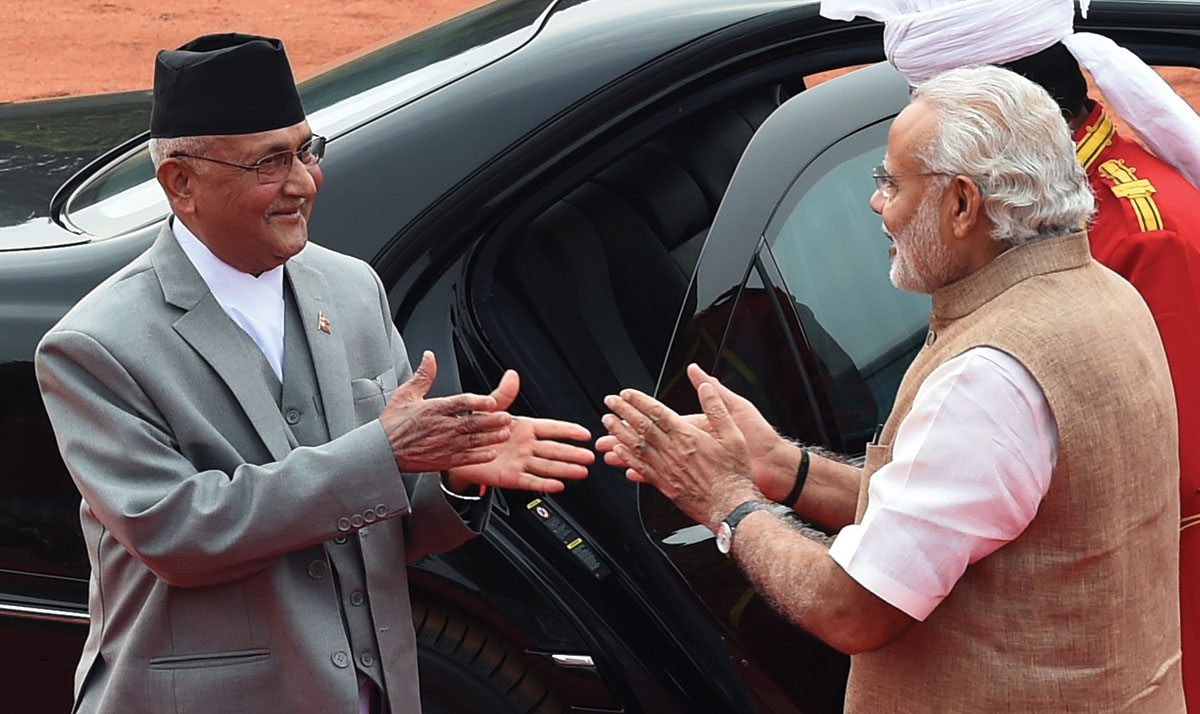THE INDIA, CHINA, NEPAL MERRY-GO-ROUND
Indian Prime Minister Narendra Modi (r) receives Nepalese Prime Minister KP Oli (l) during a ceremonial reception in New Delhi, Feb. 20. Oli was on a six-day visit to strengthen ties with India. (Money Sharma | AFP | Getty Images)
Prime Minister Narendra Modi is being lauded for his out-of-the-box foreign policy initiatives. However, dealing with immediate neighbors is turning out to be no easy matter given the complexities involved. New Delhi has had to deal with Pakistan’s double speak on the Pathankot terror attack. More recently, Indo-Nepal relations have nosedived. The ties scaled new highs in 2014, following two visits by Modi, writes Siddharth Srivastava. – @Siliconeer #Siliconeer #india @IndiaForeignPolicy #namo #Nepal #Pakistan
Equations plummeted last year during the five-month long border blockade imposed by Madhesis in the southern Terai region to protest against Nepal’s new constitution that left the demarcation of regions to be decided later. This resulted in severe scarcity of fuel from September to February as India stopped transporting fuel to Nepal in trucks. The tiny landlocked Himalayan nation depends entirely for its diesel, gasoline, kerosene and cooking gas needs from its much bigger southern neighbor, India, with which it shares a 1,850 kilometers border. The ostensible reason given by India to stop fuel supplies was safety of truck drivers, though it is anybody’s guess that New Delhi was concerned about domestic political fallouts due to shared ethnicity of populations of the Terai region in Nepal and India.
In September the Nepali government imposed draconian fuel rationing blaming India for the “embargo” to support the Madhesi conflict. India predictably denied the accusations re-iterating its stated policy of non-interference in internal matters of another country. Left with no choice, Nepal Prime Minister K.P. Oli reached out to China for support, announcing it intends to buy 30% of the country’s fuel needs from its northern neighbor. India, predictably is unhappy with Nepal pushing ahead with an independent foreign policy aimed at engaging with China.
New Delhi is always wary about the risk of being “enveloped” by Chinese influence on its immediate neighbors including Pakistan, Bangladesh, Myanmar, Sri Lanka and Nepal, whether via investments in infrastructure projects such as ports, highways, trade or military presence.
Kathmandu, on the other hand, is deeply suspicious about how India will react, given the likelihood of the Madhesi protests flaring up again. The recent actions of the governments speak for itself. Earlier this month, Kathmandu abruptly cancelled the trip of President Bidhya Devi Bhandari to India just three-days before her departure for Delhi, without any explanation.
Almost simultaneously, Nepal’s Ambassador to India Deep Kumar Upadhyay was recalled, amid allegations that he was colluding with India against Oli. The Oli government, meanwhile, barely survived being toppled by coalition partner Maoists. Thus, the prospect of Modi making a short but symbolic sojourn to Nepal this month to coincide with religious festivities linked to “Buddh Purnima” was abandoned. No doubt, Nepal has to tread carefully as its options are limited. The recourse to fuel supplies from China remains a vexed one.

Limited Options for India, Nepal
After receiving the Chinese government’s gift of 1.3 million liters of gasoline to tide over an immediate crisis, no further progress has been made on the import front. No commercial agreement has been signed due to ambiguity over double taxation on gasoline imports, high transportation costs over rugged terrain and long distance. This is despite the formation of several committees, including the latest this month, and visits by officials for multiple rounds of talks. Unless China waives local taxes, the price of Chinese petroleum products will far exceed Indian rates, which will not be acceptable by the consumers.
There are also doubts about the commercial viability of Chinese transit locations in the absence of rail connectivity. The nearest Chinese port, Tianjin, is over 3,000 kilometers away from the Nepal-China border, while the distance to the closest Indian port, Haldia, is just 1,000 kilometers from the Indo-Nepal border. Kathmandu’s China-push, however, is likely to re-calibrate India’s thinking. New Delhi, no doubt is under psychological pressure.
There is a line of thinking that Kathmandu’s open and aggressive courting of China is a direct consequence of the way the Indian government has responded to the Terai discord. Given the likelihood of the protests erupting again, there is a high possibility New Delhi will this time round continue to ply the Indian Oil trucks by ensuring adequate security cover that could involve the Nepalese Army. In order to further assuage Kathmandu, India could also green light the 41-kilometer cross border Raxaul-Amlekhgunj petroleum pipeline project. Though Nepal and India signed the agreement to build the oil pipeline in August last year, the project has not made any progress.
Like Pakistan, Nepal, however, is also a nation that continues to implode due to its internal contradictions. Though Kathmandu never shies from blaming “Big Brother” New Delhi for all its problems, Nepal’s unstable polity has contributed to the absence of a long-term strategic plan, including engaging with other neighbors such as Bangladesh, Bhutan and Myanmar to address its energy problems. India will not be averse so such ententes. Nepal has seen over 20 governments in 25 years.
The days of the Oli government also seem numbered; many believe it is just a matter of weeks that the government will collapse. Given the absence of effective administration over the years, Nepal has turned into a den of corruption, drug trade and a terrorist haven. Any solution to its problems will not happen until basics of a stable polity are sorted. This, unfortunately, may not happen soon.


